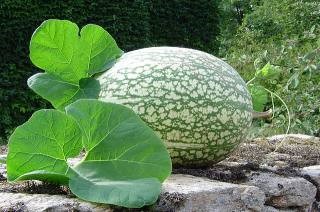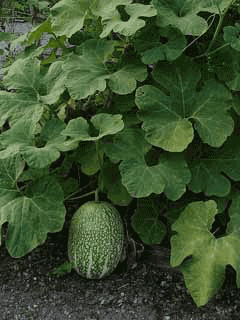Chilacayote
 Common Name: Fig-Leaf gourd, malabar gourd, black seed squash and cidra
Common Name: Fig-Leaf gourd, malabar gourd, black seed squash and cidra
Scientific Name: Cucurbita ficifolia
Climate: Hot and Temperate Warm
Plant Description: It grows in temperate highlands at elevations of up to 2000 meters. Fig-leaf gourd is a climbing, annual or perennial plant that has very long guides extending up to 15 m, yellow flowers, and large 35 cm long oval fruits. Stem has fine short hairs. The light green leaves are alternate, almost round ovates of 25 cm, their margin is wavy-toothed. The surface of the leaves is wavy with 5 lobes and they are covered with little hairs. The fruits are shaped like a balloon and are longer than they are wide. They reach 35 cm long and 20 cm wide.1 The fruit has a hard, light green peel with cream colored stripes. It has many seeds compressed inside the fruit. The roots are fibrous, strong and form a network just below the ground.
Cultivation: It is sown by seeds. The soil needs to be moist and in full sun. It adapts to various soils, but grows best in well-drained, deep, loose soils. It does not tolerate clayey soils. Before sowing the seeds it is necessary to dry them in the sun for a few days. Once the seeds are dry, they are sown in soil at a depth of 3 cm. The plant needs a lot of space to grow since it has very long stems that extend up to 15 m. Distance between seeds should be from 2 to 12 m. No fertilizer required. But it helps the plant to bear more fruit. The seeds generally germinate in 7 days. It is important to water them on a regular basis. Does not tolerate very low temperatures
For vegetable based dishes they can be harvested approximately 3 months after planting. But the plant continues to produce fruit for up to 7 months. To harvest tender fruit it is cut from the base of the guide with a knife, so that it continues to produce the rest of the season.
 Uses: The flowers, leaves, young shoots and fruit are used as food. Unripe fruit is eaten cooked, while ripe fruit is eaten sweet and in desserts. The fruit is packed with nutrients just and has numerous health benefits. Rich in antioxidants, they are also well known for their anti diabetic and anti inflammatory activity.The most nutritious is the fat and rich protein of its seeds that can vary in color from white to black. Ripe fruits are used as fodder for livestock and poultry. Wood is used to make crowbars.
Uses: The flowers, leaves, young shoots and fruit are used as food. Unripe fruit is eaten cooked, while ripe fruit is eaten sweet and in desserts. The fruit is packed with nutrients just and has numerous health benefits. Rich in antioxidants, they are also well known for their anti diabetic and anti inflammatory activity.The most nutritious is the fat and rich protein of its seeds that can vary in color from white to black. Ripe fruits are used as fodder for livestock and poultry. Wood is used to make crowbars.
Pests and Diseases: The plant appears to have more disease tolerance than many melons and therefore has been used as a rhizome in some areas.
The main pests: Red spider; Leaf borer and Fruit borer; aphids; lepidoptera, and whitefly.
References:
- Lira Saade, R. y S. Montes Hernández, 1992. Cucúrbitas. Sección La Agricultura en Mesoamérica, en J. E. Hernández Bermejo y J. León: Cultivos marginados; otra perspectiva de 1492. Colección FAO, Producción y protección vegetal No 26. FAO, Roma, Italia.
En español: Chilacayote
